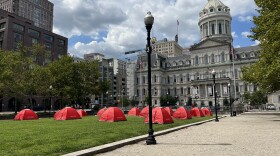Editors note: Make sure you've got the whole story! Click on the audio link to hear the names of individuals who died so far and what Baltimore City leaders are doing to stop the trend.
More than 100 people without permanent shelter experiencing homelessness have already died this year in Baltimore City, according to Health Care for the Homeless, a local nonprofit serving those without shelter.
To curb that trend which could rise to 120 deaths by Dec. 30, Baltimore leaders held a memorial on the winter solstice, the longest night of the year, for those who died without adequate shelter.
As officials look to the past to remember, this weekend is shaping up to be a dangerous holiday for people without housing.
Temperatures in the area will dip into single digit lows and nights will remain in the teens and twenties into next week.

That kind of cold can cause people to get frostbite on their extremities and lose fingers and toes or contract hypothermia, which can be a deadly combination.
“There's a point where the blood flow and metabolism are unable to sustain your body temperature of 98.6 F,” said Dr. Jeff Sternlicht, chairman of emergency medicine at the Greater Baltimore Medical Center. “At that point, the organs start to shut down, which includes the heart, the brain. It can be really severe, you can you can go into cardiac arrest when your heart gets too cold and you go into coma when your brain gets too cold.”
Baltimore issued a Winter Shelter declaration until at least Tuesday.
The city is offering pickup and drop off at shelter locations from 4 p.m. to 7:30 p.m. for residents in need. Those facilities will provide shelter until 9 a.m. the next day.
“The weather is going to be brutal. Homelessness is absolutely fatal. We know especially at temperatures like that,” said Kevin Lindamood, president and CEO of Health Care for the Homeless. “So if you see somebody, there is a dedicated shelter line in Baltimore City, it's 443-984-9540. That's 443-984-9540. It's easier to remember, call 211 The United Way's helpline or 311, the city's non-emergency, emergency line.”
Sternlicht said people suffering from hypothermia often look blue and feel cold to the touch. They may be confused and shivering.
The best course of action is to call emergency services immediately. If possible, get the person into the warmth. Remove any wet clothing, cover the person with blankets and provide warm fluids until help arrives.








